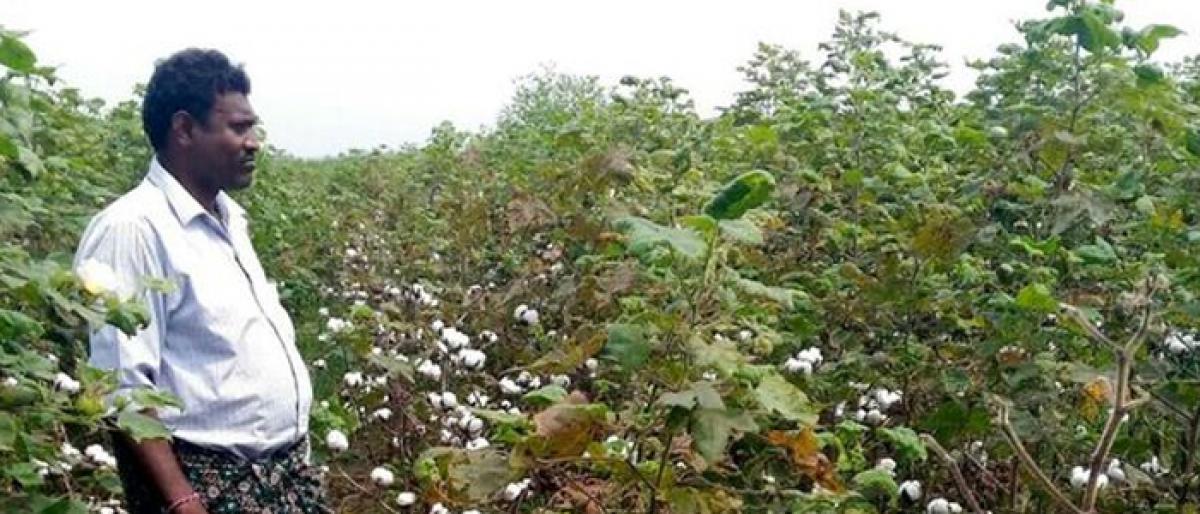Live
- TDP, JSP, YSRCP urged to oppose Wakf Bill
- T-SAT to launch new programme on ‘General Studies’
- Cops silence deafening noise of 100 bikes
- Guv inaugurates medical screening camp for Raj Bhavan staff
- Job fair for pharmacist roles tomorrow
- New ration cards to be issued in January
- Job mela at Masab Tank tomorrow
- New toilets facilitated for MPP school students
- Steps to safeguard natural springs gain momentum
- RWAs want officials to clear fog over SCB-GHMC merger
Just In

Cotton farmers in Telangana are in for a rude shock as agriculture scientists foresee a fall of 30 to 40 per cent in the cotton yield this season. There are multiple reasons, triggered by excessive rainfall this kharif, for the crisis.
Scientists foresee a fall of 40 per cent in cotton yield
Warangal: Cotton farmers in Telangana are in for a rude shock as agriculture scientists foresee a fall of 30 to 40 per cent in the cotton yield this season. There are multiple reasons, triggered by excessive rainfall this kharif, for the crisis.
The incessant rains left a triple impact on the cotton crop. Firstly, it led to excessive growth in black soil fields, where crop grown to a height of above five feet, while undergrowth of the crop is witnessed in light soil fields.
Secondly, cotton plants and the boll (fruit) become rotten due to the rains. In addition to that excessive moisture in the weather made the crop victim of pink boll worm, which according to an agriculture scientist R Uma Reddy, is uncontrollable as there is no effective pesticide available to deal with it.
The situation is adverse for cotton farmers as the catastrophe is above economic threshold level (ETL). The ETL implies presence of the larvae in a minimum of two bolls out of 20 bolls. But the larvae are found in more than four bolls.
Uma Reddy, a Principal and Coordinator of District Agricultural Technology and Transfer (DATT) at Agriculture Research Station in Warangal said the incidence of pest is found during his visits to various places across erstwhile Warangal district.
And the situation is same in other districts in the State. ‘The prediction of 40 per cent fall in yield is preliminary assessment. It can be more in the days to come.
The weather conditions are conducive for pests especially for pink boll worm which makes lint inside the boll discoloured (blackened),’ he added.
Even if there is a certain quantity of yield, the produce will not get profitable price. It is better for the farmers to destroy the crop, lest it will affect the crop in the next season too, Uma Reddy warned.
On noticing pink worm, the DATT conducted awareness programmes advising farmers to use pheromone traps to lure male worms employing sex pheromones to disrupt their mating and to control their spread.
But very few farmers have taken the advice seriously and the result is devastating, he grieved. Another factor that is making the problem severe is the acute shortage of labour to pick up cotton.
If the crop is not harvested in time, the damage can be acute. In order to address this kind of crises, there is an urgent need to strengthen research activity related to cotton, Uma Reddy suggested.
Meanwhile, what the scientists feared has already coming true. Enumamula Agriculture Market used to witness arrival of more than 30,000 bags of cotton per day at this time of the season. But now the arrivals are confined to below 15,000 bags per day.
According to the market officials, cotton is sown in 7, 59, 760 acres across erstwhile Warangal district and the production is estimated to be around 6, 14, 928 metric tonnes. Given the current scenario, the estimation is going to be upset.

© 2024 Hyderabad Media House Limited/The Hans India. All rights reserved. Powered by hocalwire.com







